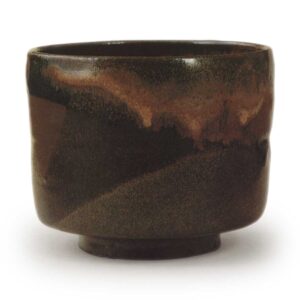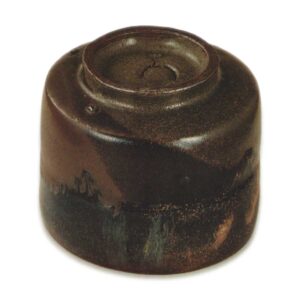

Height: 8.6cm
Diameter: 10.1-10.5cm
Height of foot ring: 6.1cm
Height of rim: 1.0cm
There are some excellent Satsuma tea bowls from the Chosa kilns. When Shimazu Yoshihiro returned home after losing the Battle of Sekigahara in 1600, he brought one of the potters he had brought back from Korea, Kim Hae (Hoshiyama Shinji), back with him. and had him build a garden kiln in the area. This is the origin of the famous Kojosa ware. In 1602, Kimi was sent to Bishu Seto to study under a master potter, and returned five years later. Since then, Seto-style pottery has been added to the Kojosa style. In 1608, Yoshihiro moved to Kajiki, to the east of Chosa, and Kan’ei also moved his kiln there. This is the Misato Kiln. It continued for 12 years until Yoshihiro’s death in 1619 at the age of 85, and the works of the Utsu Kiln in Chosa and the Misato Kiln in Kajiki are collectively known as Ko-Chosa (Old Chosa). After Yoshihiro’s death, Kan’ei was summoned by Shimazu Yoshihisa of the Shimazu family at Kagoshima Castle, and he moved to the same area with his son Kanwa, where they built a kiln in the north of the castle at Tateno Renwa, which is the origin of the famous Tateno ware, the mainstream of Satsuma ware.
The Tateno kilns are also essentially part of the Chosa lineage, but the early pieces in particular have a strong Chosa-style characteristic in their glaze and other aspects. However, as the times changed, changes were seen in the style of production, and for example, while the Oribe style was prominent in the old Chosa tea caddies, the early Tachino tea caddies showed the influence of the Enshu style, and even tea caddies with a clear Enshu-style cut shape were produced. Therefore, the term “Kosatsuma” is often used to refer to the early Tachino tea caddies, as opposed to the Kojosa tea caddies.
The most famous of the Kosatsuma tea bowls are the slightly thick, half-cylindrical bowls with slightly flared sides, which are glazed in two or more layers. The clay is a dark color and hard, and the foot ring is large, and unlike Karatsu ware, the foot ring is also glazed. The style of the pieces is similar, and they have a kind of formal tea bowl appearance. The brownish-red, matte brownish-red glaze (sometimes tinged with greenish-brown) is particularly unique, and is commonly referred to as Kosatsuma glaze, but it conveys the characteristics of Kojosa. In terms of the overall feel, there is a connection with the Enshu-style tea bowls with a running glaze from the Takatori Hakuhata Kiln, and the design of the separate or layered glaze also has a strong Enshu-style flavor.
This tea bowl is considered to be one of the best of the Kosatsuma-dote style, and both the workmanship and the glaze are flawless, making it one of the finest tea bowls made in Japan. The calligraphy on the box says “Nonomiya”, but this is of course a reference to the Nonomiya family, and the name is probably a reference to the Nonomiya purification ceremony, with the glaze design likened to flowing water.
A strip of cord-like decoration runs around the middle of the body, giving the shape a dignified tension. The design of the glaze, which is a combination of black, brown and straw-ash glazes, and the kasagake (a technique in which the glaze is applied in stripes) creates a sober yet elegant effect, and the white glaze that flows down the sides and the dots that decorate the surface are exquisite. The foot ring is also solid and substantial, and in addition to the slightly thick construction and austere glaze, there is not the slightest hint of frivolity. The fact that it retains the elegant and harmonious style of the early period is worthy of praise, and it is here that we can see the sincerity of old Satsuma ware. There is a crack in the high stand, and there are also cracks in the high stand and the side.
The accessories are
inner box paulownia plain wood lid front inscription Kobori Gonjuro “No X Palace”
The details of the history of the item are not known.



